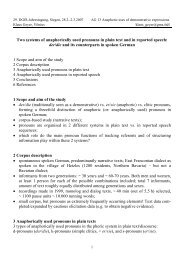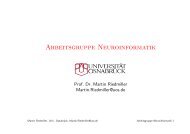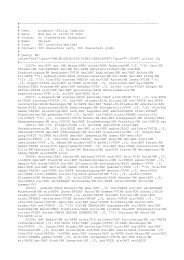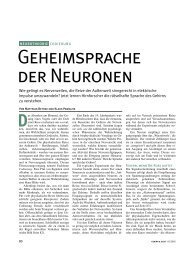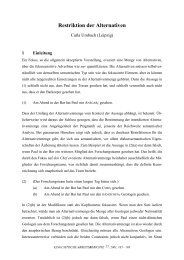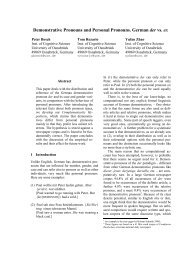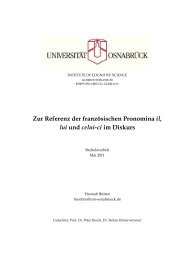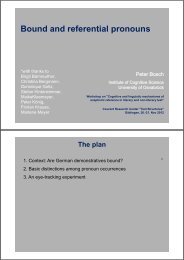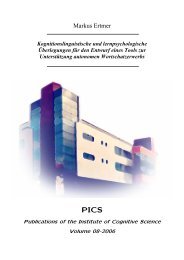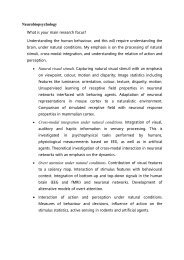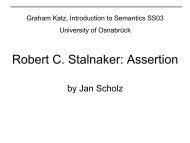Proceedings of the 6th Annual Meeting of the - Heinrich-Heine ...
Proceedings of the 6th Annual Meeting of the - Heinrich-Heine ...
Proceedings of the 6th Annual Meeting of the - Heinrich-Heine ...
You also want an ePaper? Increase the reach of your titles
YUMPU automatically turns print PDFs into web optimized ePapers that Google loves.
function from contexts to individuals. In <strong>the</strong> case <strong>of</strong> (1)a, that function maps possibilities onto <strong>the</strong><br />
individual <strong>the</strong> speaker has in mind in that possibility. In (1)b, it maps possibilities onto <strong>the</strong> unique<br />
woman nominee in that possibility. The claim is that we arrive at this understanding through a<br />
pragmatic process which involves what Stalnaker has elsewhere referred to as diagonalisation.<br />
An outline <strong>of</strong> <strong>the</strong> reasoning behind our understanding <strong>of</strong> (1)a goes as follows:<br />
(I) The assertion <strong>of</strong> <strong>the</strong> first sentence reduces <strong>the</strong> context set by eliminating worlds in which<br />
no man walked in <strong>the</strong> park. This effect is due to <strong>the</strong> conventional meaning <strong>of</strong> <strong>the</strong> first<br />
sentence uttered.<br />
(II) After <strong>the</strong> first assertion is accepted, it is presupposed that in each live possibility <strong>the</strong>re is<br />
an individual uniquely available for reference. This individual is that which <strong>the</strong> speaker had<br />
in mind in uttering <strong>the</strong> indefinite in <strong>the</strong> first sentence and this individual is a man who<br />
walked in <strong>the</strong> park.<br />
(III) Then, in each possibility, when <strong>the</strong> second utterance takes place, <strong>the</strong> pronoun refers to<br />
that individual which is uniquely salient. Thus, in each possibility in <strong>the</strong> resulting context<br />
set, a man who walked in <strong>the</strong> park whistled.<br />
Clearly, for this account to be acceptable, step II needs to be fleshed out. Stalnaker, in fact does<br />
not go in to all that much detail, assuming, as seems natural, that <strong>the</strong> details are largely self<br />
evident. However it is worthwhile considering what is supposed to be going on in <strong>the</strong>se cases in<br />
somewhat more detail as such effort will reveal a certain weakness in <strong>the</strong> account.<br />
Supposing that pronouns are variable terms <strong>of</strong> direct reference, Stalnaker plausibly argues that<br />
such terms, when used, carry a pragmatic presupposition that <strong>the</strong>re is an individual uniquely<br />
available for reference (see Stalnaker 1999:107). It is important to note that in <strong>the</strong> 2-D<br />
framework, if we assume that this presupposition is <strong>the</strong> only one which attaches to pronouns, it<br />
is not necessary that it is presupposed which individual <strong>the</strong> pronoun refers to in order to satisfy<br />
it (but only that in each possibility in <strong>the</strong> context an individual is uniquely available for reference).<br />
The idea is that we can reach an understanding <strong>of</strong> <strong>the</strong> discourse without identifying what is said.<br />
Ra<strong>the</strong>r, context (including pragmatic principles) determines a function from possibilities in <strong>the</strong><br />
context to individuals - and this function corresponds to our descriptive understanding.<br />
Note that this presupposition is quite weak. If it is accommodated without any fur<strong>the</strong>r contextual<br />
reduction, we would get an understanding <strong>of</strong> <strong>the</strong> discourse in (1)a along <strong>the</strong> lines <strong>of</strong>, “A man<br />
walked in <strong>the</strong> park. Some male whistled.” So <strong>the</strong> question arises: How does context determine<br />
<strong>the</strong> descriptive understanding in question? The answer is that those possibilities where <strong>the</strong><br />
individual available for reference is not <strong>the</strong> individual <strong>the</strong> speaker had in mind are ruled out on<br />
general pragmatic grounds. In this case and o<strong>the</strong>rs, a principle <strong>of</strong> relevance or coherence (it<br />
amounts to <strong>the</strong> same thing in this kind <strong>of</strong> case) does <strong>the</strong> job. This is so since in those possibilities<br />
where <strong>the</strong> speaker’s referent is not <strong>the</strong> referent <strong>of</strong> <strong>the</strong> pronoun, <strong>the</strong> speaker would - in <strong>the</strong> typical<br />
case - be failing to be relevant (or coherent).<br />
We should note that step III involves a quality maxim inference where we presuppose what <strong>the</strong><br />
speaker believes (i.e. that her referent was in fact a man walking in <strong>the</strong> park).<br />
26



